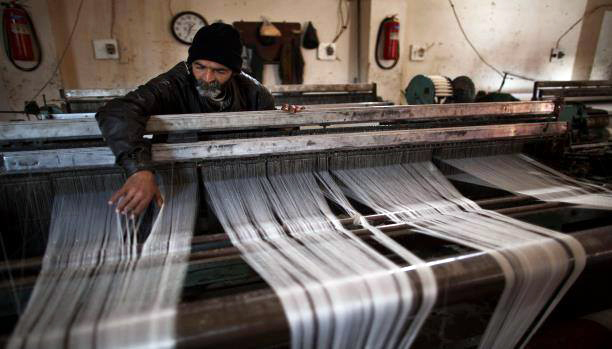



Enab Baladi Issue # 124 – Sun, July. 6, 2014
The Syrian Economic Forum published a field and analytical study entitled “Repercussions of the Syrian Crisis on the Textile Industry”, prepared by Dr, Abdullah Hamada. The study, which encompasses 301 textile factories located in northwest Syria, aims at identifying the most important strategies to support and contribute to the rehabilitation of textile factories in Syria, in order to secure the urgent needs of citizens.
According to the study, before 2011, textiles contributed to approximately 12% of the net domestic product and 63% of the industrial sector’s total production, and it accounted for approximately 20% of the labor force. Syria used to export around $3.3 billion dollars of textile products.
The study shows that 32.9% of textile mills have ceased production entirely; 27.9% of factories produce less than half of their production capacity, and 22.9% produce less than a quarter; whereas only 12.2% of factories produce at their full capacity from before the conflict.
Safety conditions proved to be one the main causes of the decline in production; the study shows thatonly 4.2% of factories have good safety conditions. The largest percentage of factories, 62.9%, was classified as somewhat safe; whereas 24.5% of the factories were classified as dangerous, and 8.4% as very dangerous.
As for the types of danger to which the factories are exposed, 76.8% of factory owners confirmed the danger of artillery shelling, 53.6% confirmed the danger of air bombing, and 63% confirmed the danger of armed groups.
The study also demonstrates the effect of power cuts on downsizing production; 69.8% of factories use electricity less than three hours a day, 17.8% between three and six hours, and 11.6% between six and twelve hours; whereas less than 1% of factories use electricity more than 12 hours a day.
The study’s statistics point that transportation services were “often” available to 37.3% of the factory owners. Most owners (48.6%) reported that the service was “sometimes” available, and 2.8% of them reported it was “rarely” available.
Concerning the discharge market, the study shows that 82.4% of textile factories produce goods for the domestic market, 2.3% export to the Arab countries, and 9.6% export to other countries.
The study also investigates the relation between production and the ability of factories to pay salaries to workers and concludes that 71.8% of factories pay salaries regularly, 21.8% pay salaries irregularly, and 6.4% have stopped paying salaries altogether.
The analytical part of study also explores a number of factors affecting the production of textiles such as number of workers, working hours, factory space, factory ownership, and factory condition. The study highlights the government actions in response to the textile factories’ crisis, and it concludes with a summary of the analytical study and a number of recommendations based on the study’s findings.
اذا كنت تعتقد/تعتقدين أن المقال يحوي معلومات خاطئة أو لديك تفاصيل إضافية أرسل/أرسلي تصحيحًا
إذا كنت تعتقد/تعتقدين أن المقال ينتهك أيًا من المبادئ الأخلاقية أو المعايير المهنية قدم/قدمي شكوى